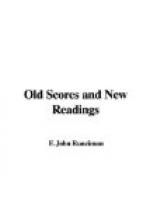uttering with unheard-of poignancy the remorse supposed
to be felt by mankind whose guilt occasioned that
suffering. The central point in the two Passions
is the same, namely, the backsliding of Peter; and
in each the words, “He went out and wept bitterly,”
are given the greatest prominence; but one need only
contrast the acute agony expressed in the song, “Ach
mein Sinn,” which follows the incident in the
“John,” with the sweetness of “Have
mercy upon me,” which follows it in the “Matthew,”
to gain a fair notion of the spirit in which the one
work, and also the spirit in which the other, is written.
The next point to note is, that while the “Matthew”
begins with lamentation and ends with resignation,
“John” begins and ends with hope and praise.
In the former there is no chorus like the opening
“Herr, unser, Herrscher,” no chorale so
triumphant as “Ach grosser Koenig,” and
certainly no single passage so rapturous as “Alsdann
vom Tod erwecke mich, Dass meine Augen sehen dich,
In aller Freud, O Gottes Sohn” (with the bass
mounting to the high E flat and rolling magnificently
down again). So in the “John” Passion
Bach has given us, first, a vivid picture of the turbulent
crowd and of the suffering and death of Christ; second,
an expression of man’s bitterest remorse; and,
last and above all, an expression of man’s hope
for the future and his thankfulness to Christ who
redeemed him. These are what one remembers after
hearing the work sung; and these, it may be remarked,
are the things that the seventeenth and eighteenth
century mind chiefly saw in the sorrow and death of
Jesus of Nazareth.
III.
The “Matthew” Passion arouses a very different
mood from that aroused by the “John.”
One does not remember the turbulent people’s
choruses, nor the piercing note of anguish, nor any
rapturous song or chorus; for all else is drowned
in the recollection of an overwhelming utterance of
love and human sorrow and infinite tenderness.
Much else there is in the “Matthew” Passion,
just as there is love and tenderness in the “John”;
but just as these are subordinated in the “John”
to the more striking features I have mentioned, so
in the “Matthew” the noise of the people
and the expression of keen remorse are subordinated
to love and human tenderness and infinite sorrow.
The small number and conciseness of the people’s
choruses have already been alluded to, and it may
easily be shown that the penitential music is brief
compared with the love music, besides having a great
deal of the love, the yearning love, feeling in it.
The list of penitential pieces is exhausted when I
have mentioned “Come, ye daughters,” “Guilt
for sin,” “Break and die,” “O
Grief,” “Alas! now is my Saviour gone,”
and “Have mercy upon me”; and, on the other
hand, we have “Thou blessed Saviour,”
the Last Supper music, the succeeding recitative and
song, “O man, thy heavy sin lament,” “To
us He hath done all things,” “For love




